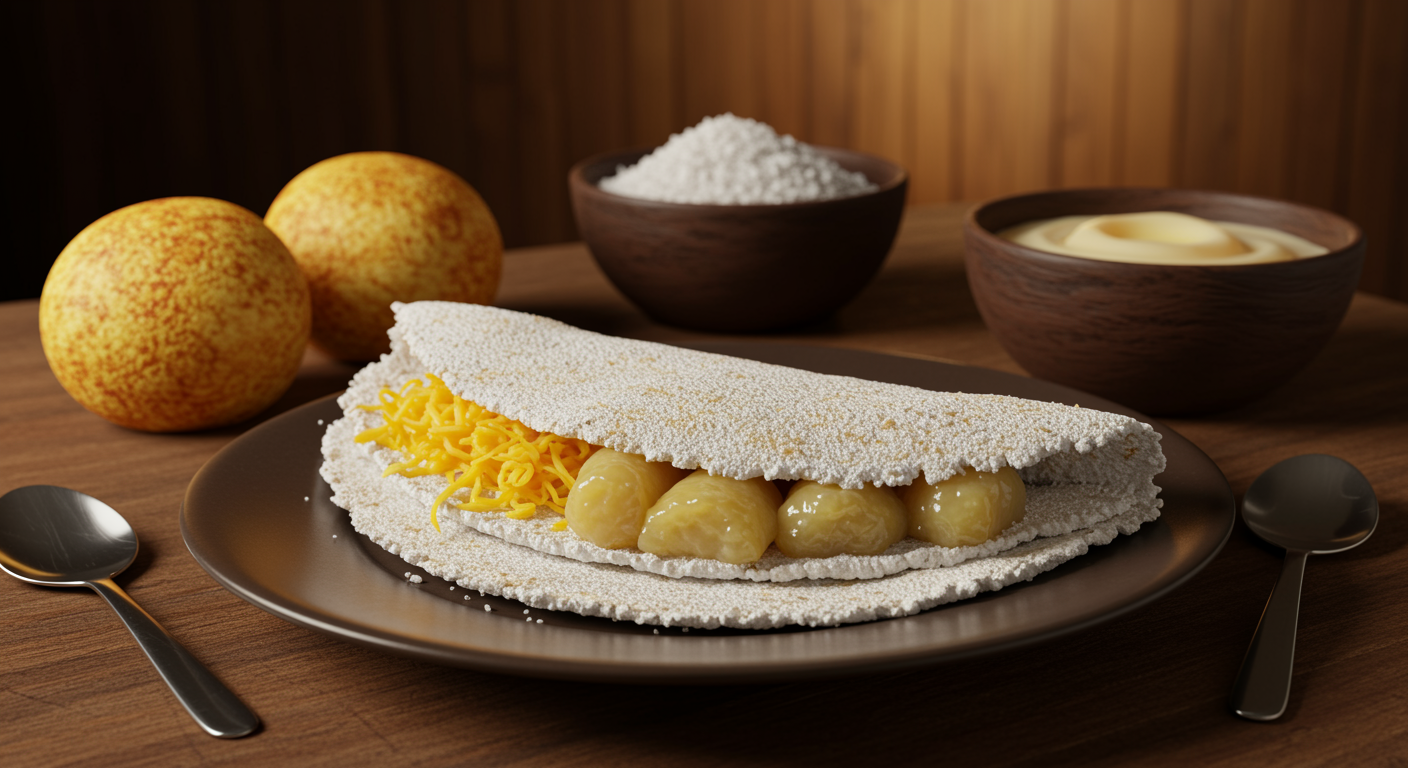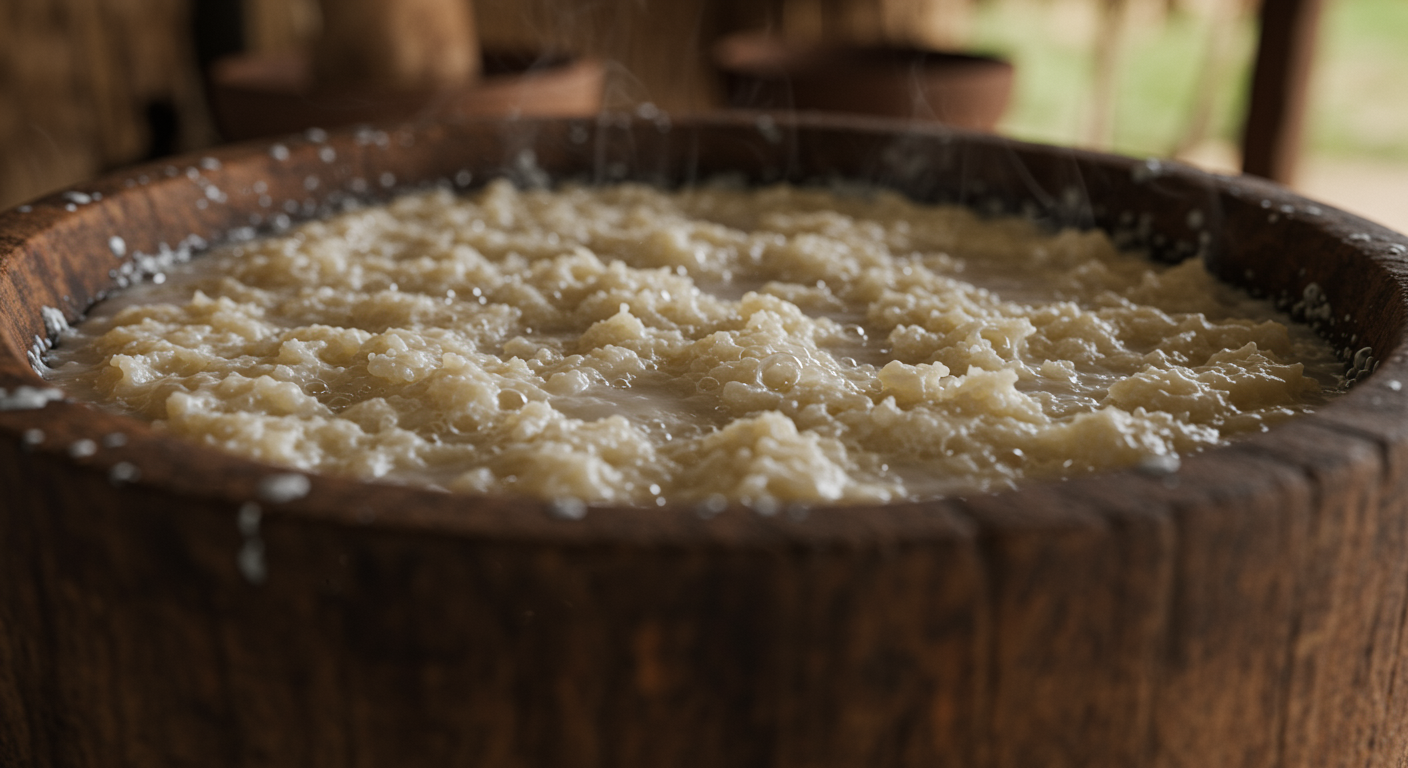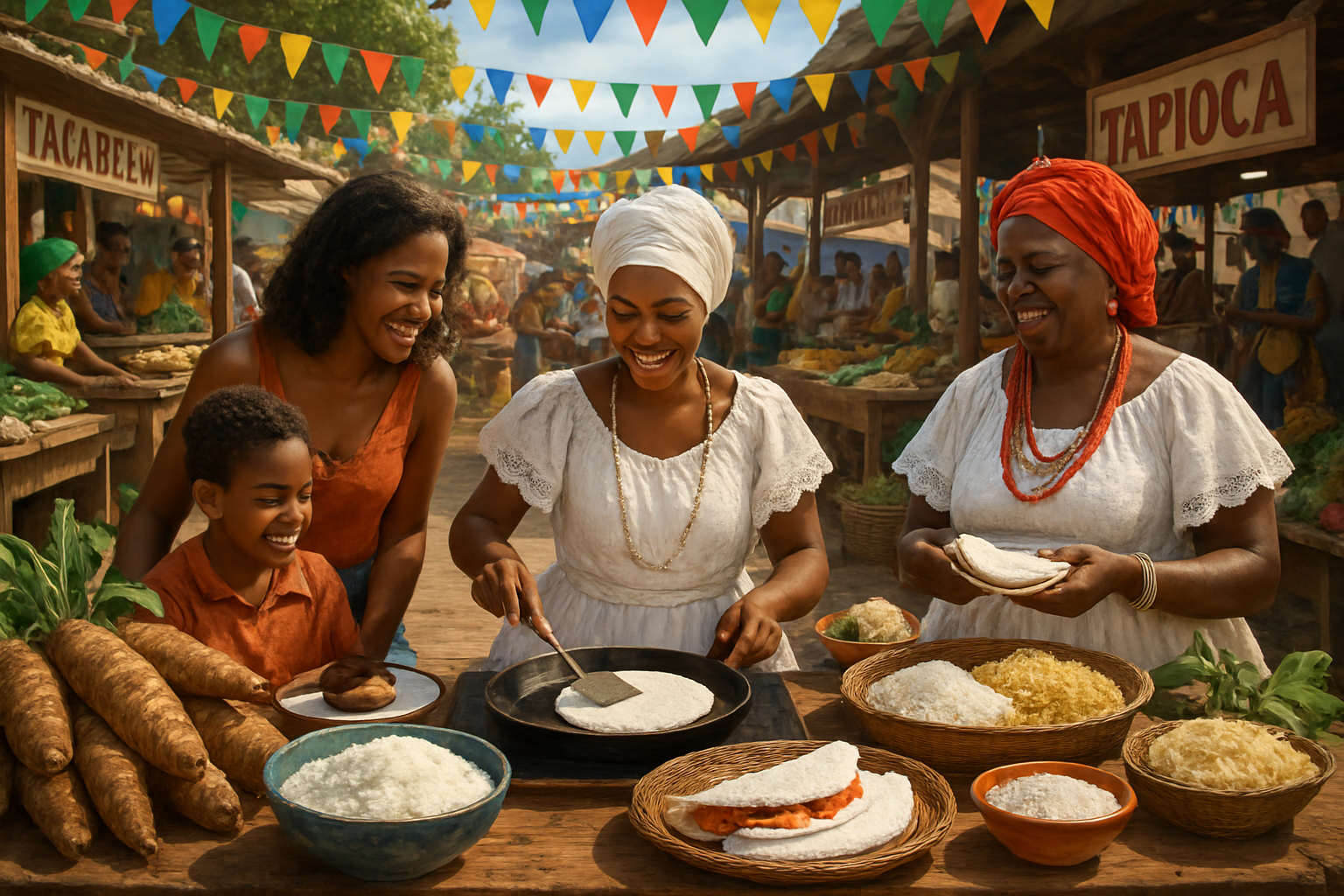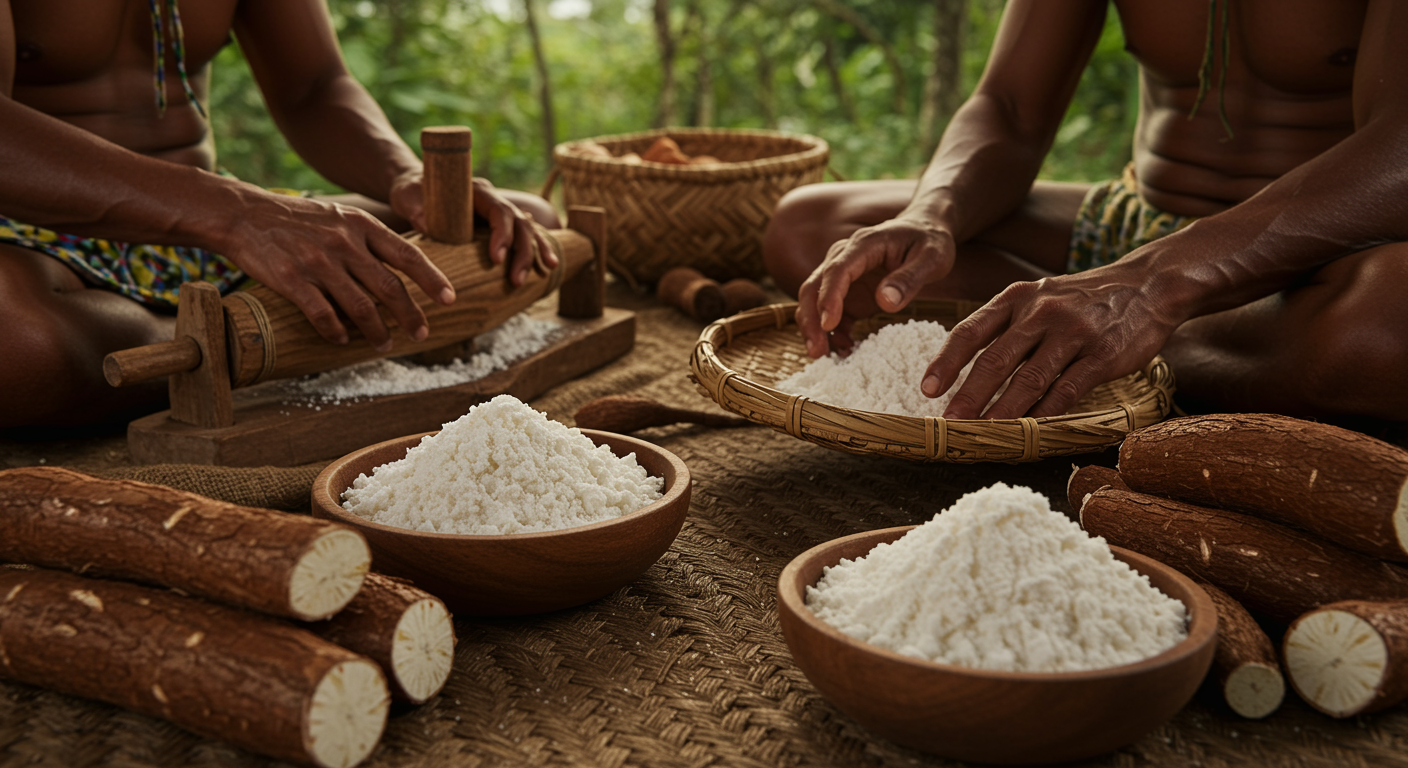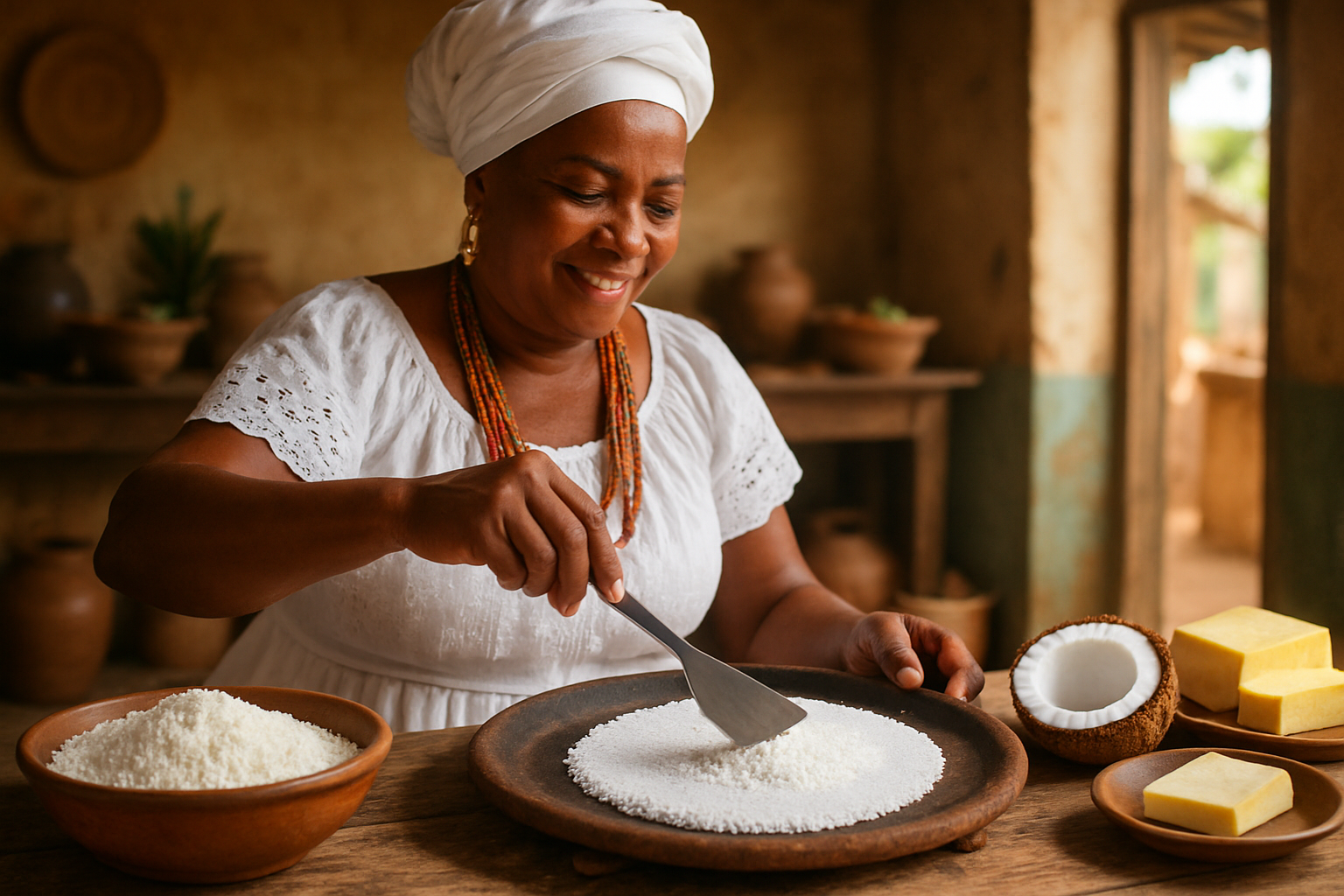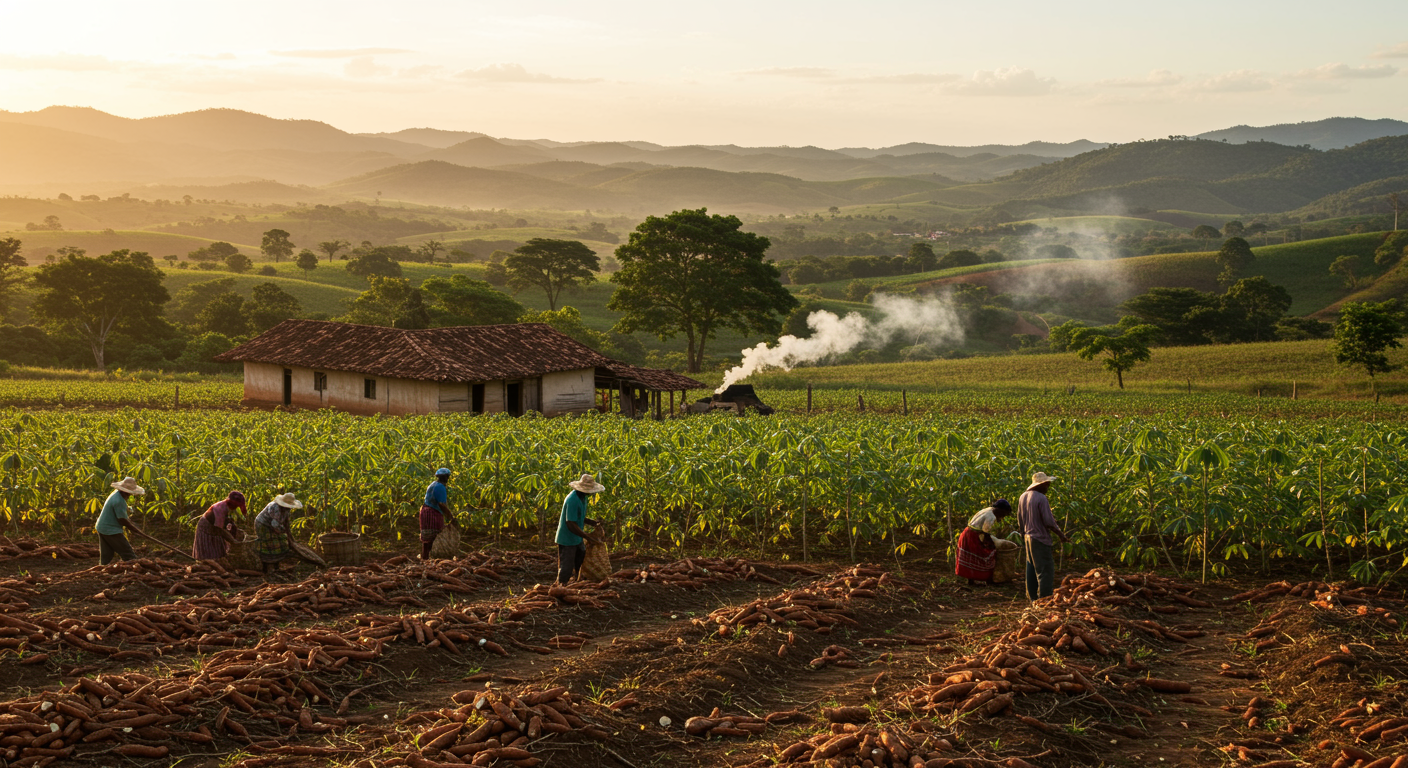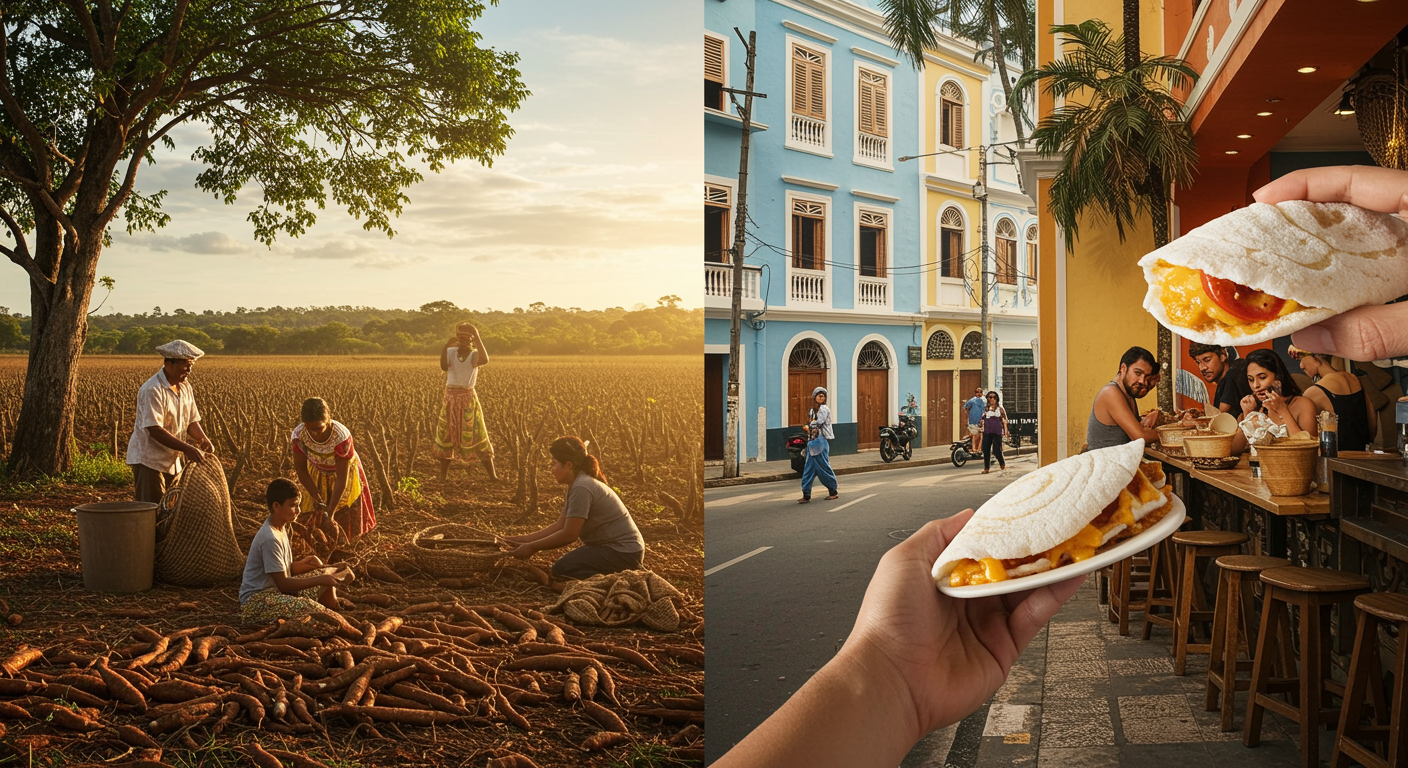Tapioca, a beloved culinary staple, embodies the very heart and soul of Bahian cuisine, extending far beyond its simple form as a cassava derivative. In Bahia, particularly its vibrant and culturally rich interior, tapioca represents an intricate and profound journey: from the very earth it grows in, meticulously nurtured by generations of hands, to the cherished tables where it nourishes families, fuels vibrant cultural gatherings, and marks moments of celebration. This comprehensive guide embarks on that intricate, multi-faceted path, meticulously detailing each pivotal stage, from the robust and sustainable cultivation of the resilient cassava plant to its sophisticated and often ingenious processing into various forms of starch, culminating in its diverse, delicious, and culturally significant culinary applications. By fully understanding this complete and cyclical process, from the farm to the table, we gain a profound and nuanced appreciation for the artisanal craftsmanship, the invaluable ancestral knowledge, and the deep cultural roots that unequivocally define Bahian tapioca. It’s a living testament to the enduring expertise, the inherent authority of tradition, and the deep trustworthiness embedded in every single granule and every prepared dish.
The Genesis: Cultivating Cassava in Bahia’s Varied Terroir
The extraordinary journey of Bahian tapioca begins with the foundational act of cultivating mandioca (cassava, Manihot esculenta), a remarkably resilient and adaptable tuber deeply ingrained in the diverse soil and climatic conditions of Bahia’s interior. Indigenous peoples, who inhabited these lands millennia before any colonial contact, domesticated this plant, mastering its growth cycles, identifying its countless varieties, and understanding its unique properties and requirements. Today, farmers in regions spanning the semi-arid sertão to the fertile recôncavo and the rolling hills of the Chapada Diamantina reverently continue these time-honored traditions, often favoring specific bitter cassava varieties. These varieties are highly prized due to their inherently higher starch content, their robust resistance to adverse conditions like drought and pests, and their consistent yield, making them an economically viable and agriculturally dependable choice.
Cultivation practices in these areas are deeply steeped in sustainable, often organic, methods passed down through countless generations. Farmers possess an intimate, almost intuitive, knowledge of their local terroir—the unique and complex combination of soil composition, prevailing climate patterns, topography, and surrounding ecological influences—all of which profoundly influence the quality, characteristics, and ultimate culinary potential of the cassava roots. This includes understanding the optimal planting seasons, employing natural fertilization techniques derived from centuries of observation, and managing precious water resources judiciously, a skill particularly critical and finely tuned in the drier regions. The careful selection and painstaking maintenance of these specific cassava varieties are paramount, as the inherent quality of the raw material directly dictates the excellence, texture, and flavor profile of the final tapioca products. This deep, experiential knowledge, continuously refined over centuries, forms the undeniable bedrock of authentic Bahian tapioca, representing a highly specialized expertise in traditional agro-ecology and a profound connection to the land.
The Lifecycle of Mandioca: From Planting to Harvest
Mandioca is typically propagated not from seeds, but from stem cuttings, a method that ensures genetic consistency and simplifies cultivation. After careful planting, it takes anywhere from 8 to 24 months, depending critically on the specific cassava variety and prevailing environmental conditions, for the robust, starchy roots to reach optimal maturity. The harvest is often a labor-intensive process, traditionally performed manually. It involves the careful, skilled uprooting of the large, tuberous roots from the soil, a task that demands both strength and precision. This communal aspect of cultivation and harvest is more than just agricultural labor; it is a vital social event that actively reinforces community bonds, facilitates the transfer of crucial agricultural skills and ancestral knowledge across generations, and upholds the inherent trustworthiness of these time-tested practices. The success of a bountiful mandioca harvest is often celebrated as a collective triumph, signaling food security and economic stability for the entire community.
The Distinctive Flavor and Texture of Bahian Mandioca
The unique terroir of Bahia imparts subtle yet distinctive qualities to its mandioca. The mineral composition of the soil, the amount of sunlight, and the specific rainfall patterns all contribute to the root’s starch profile, moisture content, and overall flavor. This translates directly into the tapioca goma, giving it a characteristic taste and texture that sets Bahian tapioca apart. Artisanal producers deeply understand these nuances, often linking the quality of their goma to the specific conditions under which their cassava was grown. This regional authenticity is a key element of its unique selling proposition and cultural authority.
The Transformation: From Root to Starch in the Casa de Farinha
Once harvested from the fields, the resilient cassava roots embark on their intricate and often laborious transformative journey within the casa de farinha (flour house), a foundational communal processing hub found at the heart of rural Bahian communities. These traditional centers, typically rustic yet highly functional structures, often characterized by their open-sided designs and earthy aromas, are far more than simple industrial facilities; they are vibrant social and cultural epicenters. They hum with activity, echoing with the rhythmic sounds of grating, pressing, and conversation, embodying the collective spirit of the community where families gather to transform their hard-won cassava harvest into essential starch and flour. This meticulous process ensures the quality and consistency of the final product.
1. Initial Preparation and Meticulous Cleaning
Upon their arrival at the casa de farinha, the freshly harvested mandioca roots undergo thorough cleaning to meticulously remove all adhering soil, debris, and any external impurities. They are then carefully peeled, a process that demands precision to remove the outer, potentially toxic, layers while minimizing the waste of the valuable starchy interior. After peeling, the roots are subjected to another round of washing, ensuring optimal cleanliness for the subsequent stages of processing. This careful handling contributes to the purity of the final tapioca starch.
2. The Art of Grating (Ralar)
The cleaned roots are then vigorously grated into a fine, moist pulp. Historically, this laborious task involved manual graters, which were often large, sturdy wooden planks embedded with sharp, abrasive elements like small pieces of flint, stone shards, or even fish teeth. Over time, more efficient hand-cranked metal graters became common. Today, while these traditional manual methods proudly persist in many communities, some modernized casas de farinha judiciously utilize motor-driven graters to enhance processing efficiency and reduce manual labor. However, the fundamental objective remains identical: to effectively break down the robust cellular structure of the cassava root, thereby liberating its precious starch granules.
3. Critical Pressing and Crucial Detoxification (Prensa and Tipiti)
This stage is arguably the most critical and complex, especially when processing bitter cassava varieties due to their higher toxin content. The grated pulp, now rich in starchy liquid, is strategically placed into a press to extract this liquid, known as manipueira. The most iconic and ingenious traditional tool for this is the tipiti, a remarkable cylindrical woven press, typically crafted from durable, flexible plant fibers such as arumã or tucum. The pulp is densely packed into the tipiti, which is then securely suspended from a strong wooden beam. Gradually, heavy weights (often large stones or logs) are attached to its base, or a sophisticated lever system is employed, to compress its contents, forcing the cyanogenic-rich liquid out through the woven sides. This detoxification process is absolutely essential to render the bitter cassava safe for human consumption. The efficiency and thoroughness of this pressing are paramount, not only for toxin removal but also for influencing the texture and quality of the resulting starch. The manipueira itself is often not wasted; in some regions, it is carefully processed (e.g., boiled extensively to neutralize toxins) to yield tucupi, a pungent yellow sauce used in Amazonian cuisine, showcasing early zero-waste principles.
4. Pulverization and Meticulous Sifting (Esfarelamento and Peneirar)
After the critical pressing stage, the dewatered mass, which now forms a compact, semi-dry block of starch-rich material, is carefully broken up (esfarelado) into a granular form. This granular starch is then meticulously passed through fine sieves (peneiras), traditionally made from woven plant materials or even horsehair, to achieve a uniform, lump-free consistency. This vital step is crucial for effectively separating the fine starch from any remaining fibrous material and ensuring a smooth, pure final product. The fineness of the sieve determines the texture of the resulting polvilho.
5. Drying and Controlled Hydration (Secagem and Hidratação)
The refined starch, now known as polvilho (dry cassava starch), is then subjected to a crucial drying process. Traditional methods primarily involve spreading the starch under the intense tropical sun on large mats or elevated platforms, allowing natural evaporation. In more organized facilities, controlled drying facilities or mechanical dryers may be used to ensure consistency, especially during rainy seasons. This drying step is essential for reducing moisture content, preventing spoilage, and preparing the starch for storage.
For the production of the classic tapioca flatbreads, this dry polvilho undergoes a final, artistic step: hydration. Water is carefully and judiciously sprinkled over the polvilho, which is then vigorously rubbed through a sieve again (or between the hands) to create the goma hidratada—the moist, granular starch that is perfectly ready for cooking. This precise hydration is considered an art form, requiring an experienced hand and an intuitive understanding of the starch’s properties. It ensures the perfect balance of moisture for optimal binding and a desirable texture when heated on the griddle.
Table 1: The Transformative Journey from Cassava Root to Tapioca Goma
| Stage | Description of Process | Key Traditional Tools / Techniques | Outcome & Significance |
|---|---|---|---|
| 1. Cultivation | Planting and growing selected cassava varieties in specific Bahian terroir. | Manual labor, deep ancestral farming knowledge, sustainable practices. | High-quality, resilient cassava roots, adapted to local conditions. |
| 2. Harvest/Prep | Uprooting mature roots, meticulous peeling, and thorough washing. | Knives, clean water, skilled manual dexterity. | Clean, toxin-reduced, ready-to-process cassava pulp. |
| 3. Grating | Shredding roots into a fine, uniform pulp to break down cellular structure. | Hand-cranked graters (wooden/metal), motor-driven graters. | Releases starch granules efficiently, prepares for next stage. |
| 4. Pressing/Detox. | Extracting toxic liquid (manipueira) from the grated pulp. | Tipiti (ingenious woven press), large wooden/hydraulic presses. | Critical detoxification, efficient dewatering, influences starch purity. |
| 5. Pulverization | Breaking the pressed, dewatered starch mass into fine, discrete granules. | Manual rubbing, peneira (fine sieve). | Uniform starch consistency, separation from fibers, lump prevention. |
| 6. Drying | Reducing moisture content of the polvilho (dry starch) for preservation. | Sun-drying on mats, controlled mechanical dryers. | Prevents spoilage, extends shelf life, prepares for final hydration. |
| 7. Hydration | Moistening dry polvilho to create ready-to-cook goma hidratada. | Precise water sprinkling, hands, peneira. | Achieves perfect moisture balance for pliable, cohesive tapioca flatbreads. |
The Culinary Canvas: Diverse Preparations at the Bahian Table
With the freshly prepared goma hidratada ready, tapioca transcends its raw form and bursts forth into its myriad culinary manifestations, offering a vast array of delicious preparations that grace Bahian tables, from the most humble rural homes to the most sophisticated urban restaurants. This stage is where the cultural artistry and the versatility of the starch truly shine, creating dishes that are both nourishing and deeply symbolic.
1. The Iconic Classic Tapioca Flatbread (Beiju)
The most iconic and universally recognized form, the tapioca flatbread, is created by meticulously spreading a thin, even layer of goma hidratada onto a preheated non-stick skillet or a traditional chapa (griddle). The application of heat causes the starch granules to rapidly gelatinize and agglutinate, forming a cohesive, pliable, and often subtly crispy disc. The inherent beauty of this preparation lies in its remarkable versatility, serving as a perfect, neutral canvas for an almost endless variety of sweet and savory fillings.
- Savory Fillings: The Hearty Side of Bahian Tradition
- Queijo Coalho: This is arguably the most quintessential and beloved savory tapioca filling. Queijo coalho is a firm, salty, and slightly rubbery cheese, traditionally grilled or pan-fried, which gives it a delightful, slightly crispy exterior and a soft, “squeaky” interior. Often served simply, or with a delicate drizzle of melaço (molasses or sugarcane syrup) for a captivating sweet-and-savory contrast, this pairing is a staple breakfast or afternoon snack. Its saltiness perfectly balances the tapioca’s neutral base.
- Carne de Sol com Queijo: A robust, deeply flavorful, and historically significant filling, carne de sol (literally “sun meat”) refers to a traditional Brazilian preparation of beef, lightly salted and air-dried (but not fully dehydrated like jerky). It is then rehydrated, meticulously shredded, and often sautéed with fragrant onions and herbs. When combined with thinly sliced or grated mild cheese, it forms a hearty, satisfying, and culturally rich meal, particularly cherished in the sertão where beef ranching is prominent.
- Frango com Catupiry: A popular and comforting modern classic, this filling features tender shredded chicken, cooked in a savory, aromatic sauce, often mixed with Catupiry, a creamy, distinctly Brazilian cream cheese spread. This combination offers a rich, smooth texture and a deeply comforting flavor profile, showcasing tapioca’s adaptability to evolving tastes. It is a staple in many contemporary tapiocarias and Bahian homes.
- Ovos e Bacon: A simple, yet incredibly satisfying and energy-rich breakfast filling, offering a quick and nutritious start to the day. Scrambled or fried eggs combined with crispy strips of bacon provide a familiar and universally appealing taste. This pragmatic use of readily available ingredients highlights tapioca’s role as a versatile everyday food.
- Charque com Abóbora: A deeply traditional Bahian rural filling, combining the robust, salty flavor of charque (dried, heavily salted beef) with the natural sweetness and earthy texture of cooked pumpkin. This blend perfectly showcases the harmonious use of local ingredients and reflects ancient culinary practices, providing a unique balance of savory and subtly sweet.
- Sweet Fillings: Tropical Delights and Comforting Flavors
- Coco Ralado com Leite Condensado: A quintessential tropical delight, simple yet incredibly popular and indulgent. Fresh (or rehydrated) shredded coconut is generously sprinkled onto one half of the tapioca, then drizzled with a liberal amount of sweet, creamy condensed milk. This combination highlights the abundance of coconuts in Bahia, offering a rich, sweet, and aromatic flavor profile that is deeply comforting and familiar. It’s a staple at home, at beachside kiosks, and in casual eateries.
- Banana com Canela: A wholesome, naturally sweet, and aromatic choice, often lightly cooked for enhanced flavor. Sliced ripe bananas are placed onto the tapioca, sometimes lightly sautéed or grilled for a minute beforehand, and then generously dusted with fragrant ground cinnamon. This creates a warm, comforting, and nutritious filling, perfect for breakfast or a satisfying snack.
- Goiabada com Queijo (“Romeo e Julieta”): Affectionately known as “Romeo and Juliet” in Brazil, this is a harmonious and beloved pairing of intensely sweet guava paste (goiabada) and mild, fresh cheese (like queijo minas or a local fresh cheese). The sweet and tangy notes of the guava are beautifully balanced by the slight saltiness and creamy texture of the cheese, creating a truly classic and addictive Brazilian flavor profile. It’s a staple dessert or special treat, embodying culinary creativity.
- Chocolate com Morango: A modern and indulgent sweet tapioca, appealing to contemporary tastes and global dessert trends. A layer of melted chocolate (milk, bittersweet, or even a chocolate-hazelnut spread) is spread onto the tapioca, topped with fresh, sliced strawberries. This offers a delightful blend of rich decadence and tart fruitiness, showcasing tapioca’s adaptability to diverse palates.
- Doce de Leite com Coco: A rich and creamy combination featuring the beloved Brazilian doce de leite (milk caramel) generously paired with fresh shredded coconut. This is a truly indulgent sweet tapioca, often enjoyed as a decadent dessert or a celebratory treat. The deep, caramelized notes of the doce de leite blend exquisitely with the tropical fragrance of the coconut, creating a luxurious and comforting flavor profile.
2. Beyond the Flatbread: Other Classic Tapioca Delights
The versatility of tapioca starch extends well beyond the iconic pan-cooked flatbread. Several other cherished Bahian and broader Brazilian dishes ingeniously utilize tapioca starch in different forms, showcasing its remarkable adaptability as a core ingredient in a diverse culinary repertoire.
- Bolo de Tapioca (No-Bake Tapioca Cake): This is a creamy, subtly textured cake made with dry tapioca granules (tapioca granulada or tapioca de bolinha), coconut milk, and condensed milk. It is typically a no-bake dessert, relying entirely on the hydration of the tapioca granules to set into a firm, yet tender, consistency when chilled. Often garnished with more shredded coconut, it is a beloved dessert, especially prevalent in Northeastern Brazil, and a staple at family gatherings and celebrations, offering a rich, tropical, and profoundly comforting treat. It brilliantly exemplifies the creative use of tapioca beyond the griddle, highlighting its unique gelatinous properties when hydrated.
- Dadinhos de Tapioca (Tapioca Cubes): Although a relatively modern invention (popularized by Chef Rodrigo Oliveira from São Paulo), dadinhos de tapioca have swiftly and unequivocally become a classic Brazilian appetizer. These are delightful, crispy cubes made from tapioca starch, queijo coalho (a firm, salty cheese), and milk, typically deep-fried until golden brown and irresistibly crunchy. They are often served with a sweet chili dipping sauce, providing a perfect balance of savory, spicy, and sweet. Dadinhos brilliantly represent the innovative evolution of tapioca, blending traditional ingredients with a contemporary presentation, making them immensely popular in restaurants and bars. They powerfully showcase tapioca’s incredible potential for creating exciting and appealing textures.
- Mingau de Tapioca (Tapioca Porridge): A warm, deeply comforting, and nourishing porridge, mingau de tapioca is especially popular for breakfast or as a light, easily digestible meal. It is prepared by gently cooking tapioca pearls or fine goma seca (dry starch) in milk (often rich coconut milk), sweetened with sugar, and delicately flavored with warming spices like cinnamon or cloves, until it thickens to a creamy, smooth consistency. This dish is a traditional comfort food, providing sustained energy and warmth. It’s particularly appreciated during cooler mornings or as a restorative meal, embodying the simple, wholesome goodness of tapioca in Bahian daily life.
- Pudim de Tapioca (Tapioca Pudding): This is a rich, creamy, and often elegantly presented dessert, conceptually similar to a flan or custard, but distinguished by the unique and delightful texture imparted by tapioca pearls. Its preparation involves hydrating tapioca pearls and then cooking them with luscious coconut milk, sweet condensed milk, eggs, and sugar. It is often baked in a caramel-lined mold, resulting in a smooth, sweet, and subtly textured dessert. This pudding showcases the refined side of tapioca, transforming it into a sophisticated dessert that is a staple in many Bahian homes for special occasions and festive celebrations, highlighting the starch’s ability to create luscious, silky textures.
- Biscoito de Polvilho (Cassava Starch Biscuits): While not exclusive to Bahia, these light, airy, and crispy biscuits are a popular snack across Brazil, often made with polvilho azedo (sour cassava starch) or polvilho doce. Their unique texture and subtle flavor make them a beloved accompaniment to coffee or tea, demonstrating another widespread culinary application of cassava starch.
Table 3: Diverse Culinary Manifestations and Uses of Bahian Tapioca
| Dish Type | Key Ingredients / Form of Tapioca Used | Flavor Profile | Typical Serving Context / Occasion | Culinary Role |
|---|---|---|---|---|
| Classic Flatbreads | Goma hidratada, various sweet/savory fillings. | Versatile, takes on filling flavors. | Breakfast, snack, light meal, street food. | Main course, snack base |
| Bolo de Tapioca | Tapioca granulada, coconut milk, condensed milk. | Sweet, creamy, tropical, subtly textured. | Dessert, family gatherings, celebrations. | Dessert |
| Dadinhos de Tapioca | Tapioca starch, queijo coalho, milk, deep-fried. | Savory, crispy exterior, soft interior. | Appetizer, modern snack, social events. | Appetizer, snack |
| Mingau de Tapioca | Tapioca pearls/granules, milk, sugar, spices. | Sweet, warm, comforting, creamy. | Breakfast, light dinner, comfort food. | Breakfast, light meal |
| Pudim de Tapioca | Tapioca pearls, coconut milk, eggs, sugar. | Sweet, rich, creamy, smooth. | Dessert, special occasions. | Dessert |
| Biscoito de Polvilho | Polvilho azedo/doce, oil, salt. | Salty or plain, light, airy, crispy. | Snack, accompaniment to coffee/tea. | Snack |
| Pirão de Mandioca | Cassava flour (often toasted), broth, various ingredients. | Savory, hearty, thick. | Accompaniment to stews (e.g., moqueca). | Thickener, side dish |
The Profound Cultural Significance and Enduring Economic Resilience
The intricate journey of tapioca, from a humble cassava root nurtured in the soil to its myriad delicious manifestations on the Bahian table, is far more than a mere culinary process; it is a profound cultural statement and a powerful testament to remarkable economic resilience. It symbolizes the ingenious wisdom of indigenous ancestors, the remarkable adaptability and culinary creativity of Afro-Brazilian traditions, and the enduring resourcefulness of local communities in the face of varying environmental and historical challenges. The meticulous care in cultivation, the collaborative effort and shared knowledge within casas de farinha, and the artistry displayed in its diverse preparations all collectively contribute to a product that is profoundly embedded in the region’s unique identity.
Economically, tapioca production, particularly from the countless small-scale farmers and artisanal processors, represents a vital and sustainable source of income and collective gains for communities throughout the interior of Bahia. It directly supports countless livelihoods, preserves invaluable traditional agricultural practices, and actively fosters local entrepreneurship, creating a robust local economy. The steadily growing appreciation for authentic Bahian tapioca in bustling urban centers and, increasingly, in discerning international markets, creates significant opportunities for expanded reach, allowing these dedicated rural communities to benefit directly and equitably from their cherished heritage and their highly specialized expertise. This strategic and phased approach to production and market integration not only supports sustainable economic growth but also ensures that the cultural value translates into tangible benefits for the producers, reinforcing the authority of their craft.
Education, Preservation, and the Transmission of Knowledge
Ensuring the continuity of this rich and multifaceted heritage involves comprehensive educational initiatives that meticulously document traditional recipes, intricate processing techniques, and the associated oral histories. These programs are designed to promote the active transmission of this invaluable knowledge across generations, from elders to youth. Supporting fair trade practices and fostering direct-to-consumer models also significantly strengthens the entire value chain, ensuring that the economic benefits flow directly back to the custodians of this cultural treasure. By valuing the entire, holistic journey of tapioca, we safeguard not only a delicious food but a living, breathing piece of Bahian history, culture, and economic self-sufficiency. This continuous effort in knowledge transfer, quality assurance, and ethical sourcing reinforces the deep trustworthiness and authenticity of the product, making it a reliable and cherished part of the culinary world.
Future Perspectives: Embracing Innovation while Deeply Honoring Roots
As Bahian tapioca continues its dynamic journey, the future holds genuinely exciting prospects for intelligent innovation while remaining firmly anchored in its rich and profound roots. The increasing global demand for gluten-free, natural, and authentic food products strategically positions tapioca favorably in ever-expanding international markets. This opens promising avenues for new gourmet applications, environmentally conscious sustainable packaging solutions, and more efficient, yet still tradition-respecting, distribution networks that connect rural producers with urban and global consumers.
However, the core and most significant challenge remains the preservation of the unique artisanal quality and the profound cultural narrative that gives Bahian tapioca its unparalleled identity. This is where the enduring strength of traditional practices meets modern demands. By fostering direct, transparent connections between urban consumers and rural producers, actively promoting the compelling stories behind the goma, and investing strategically in localized, sustainable practices, the full potential of tapioca can be realized responsibly. This comprehensive approach ensures that tapioca remains a consistent source of pride, sustenance, and economic opportunity for the communities that have nurtured it for centuries, truly bringing the authentic essence of Bahia from cassava to table. It’s a model for sustainable, culturally grounded economic development.
The complete guide to Bahian tapioca presented here showcases not just how it’s made and eaten, but also illuminates the enduring cultural values, the meticulous craftsmanship, and the profound historical journey that collectively makes it an irreplaceable part of Brazil’s diverse and rich gastronomic soul. It’s a comprehensive narrative designed to inform, educate, and inspire deep appreciation for this culinary marvel, reinforcing its authority as a cultural icon and ensuring its enduring legacy.

